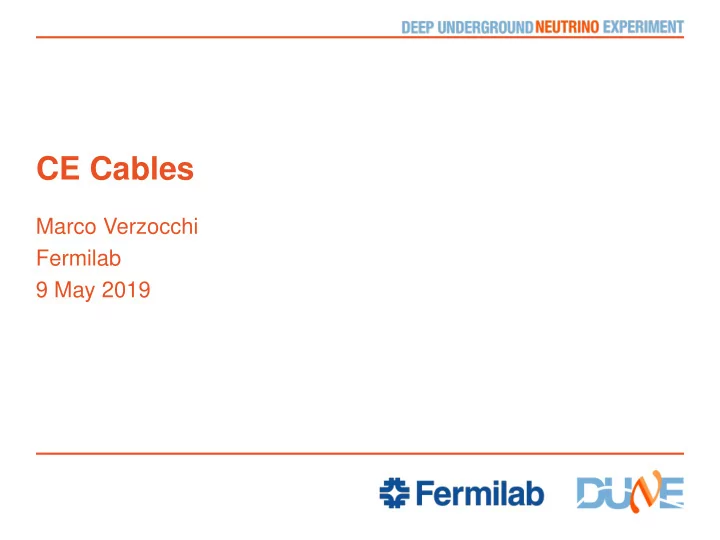

CE Cables Marco Verzocchi Fermilab 9 May 2019
CE cables routing • We have to route the cables for the lower APA through the tubes of the APA frame - 10 “signal” bundles on each side tube (one cable per FEMB) - 10 low voltage power bundles on each side tube (one cable per FEMB) - 8 bias voltage cables on one side tube (SHV board only at one end of the APA) • ProtoDUNE cables - “signal bundle”: 12 low -skew shielded twin-axial cables with custom designed connector (PCB on the cable side) - low voltage power bundle: 9 AWG20 twisted pair cables with SAMTEC IPL1 connector - bias voltage cables: RG-316 coaxial cables with SHV connector 2 9 May 2019 M. Verzocchi | CE Cables
The problem • The frame size was increased to 4” x 4” to make sure that the cables for the lower APA would fit - Added conduit with 2.5” diameter, CE bundle runs inside the conduit - Made the assumption that we could decrease the number of connections • Tests done with 9 “ ProtoDUNE signal bundles” and 9 “ ProtoDUNE low voltage power bundles” - 9 “ ProtoDUNE signal bundles” = 108 low skew twin -axial cables - 9 “ ProtoDUNE low voltage power bundles” = 81 AWG20 twisted pair cables • Assumption was made we could reduce the number of connections - 10 “signal” connections per FEMB (10*10=100 < 108) - 8 “low voltage power” connections per FEMB (8*10=80 < 81) • Except for the connectors (that are anyhow staggered) the tests done so far would be meaningful if we the DUNE FEMBs work with these connections 3 9 May 2019 M. Verzocchi | CE Cables
Does it work (signal)? • Can the WIB communicate with the FEMB with only 10 connections (12 in ProtoDUNE) ? Yes - four connections for readout at 1.28 Gbps (two connection for each COLDATA chip) - two 64 MHz clock lines (one for each COLDATA chip) - one fast command line (shared between two COLDATA chips) - three I2C-like control lines (clock, data-in, data-out, arrive at one COLDATA chip, that then shared the I2C information with the second COLDATA chip) • This requires that the fast command line (~2 MHz signal) is shared (i.e. single line connected to both ASICs) between the two COLDATA chips - to be demonstrated with tests when we build the first FEMBs (late Summer 2019) 4 9 May 2019 M. Verzocchi | CE Cables
If it doesn’t work (signal) • Alternatives - transmit data at 2.56 Gbps (reduce number of data transmission lines from 4 to 2) - daisy chain I2C connection between different FEMBs (requires inter-FEMB connections) • Alternatives allow for - further reduction in cable bundle size - build redundancy • Alternatives may have their own risks / complications 5 9 May 2019 M. Verzocchi | CE Cables
Does it work (LV power)? • Can the WIB provide enough power to the FEMB with just 8 twisted pairs ? - Yes, see document attached to these slides - Each FEMB consumes at most 47 mW per channel at 2.5V (2.4 A total) Power provided with 7 AWG20 pairs (8 th pair used to provide bias - voltage to the linear voltage regulator) - At warm: bundle of 7 AWG20 twisted pair wires has resistance of 41 m for 9 m length (upper APA), 101 m for 22 m length (lower APA), to compensate voltage drop WIB will provide 2.7V to upper APA, 3.0V to lower APA, power dissipated in cables: 0.5W per FEMB (upper APA), 1.2W per FEMB (lower APA) - At cold: resistance and power dissipation in cables reduced by factor 3 (operate at ~2.6V for upper APA, 2.7V for lower APA) - Lower APA: at most 10W total dissipated inside each APA side tube when cold (power for 20 FEMB is 120 W) 6 9 May 2019 M. Verzocchi | CE Cables
Does it work (LV power)? • Voltage drop is still reasonable (particularly when cold) • Exact value of voltage provided from the WIB to the FEMBs will be configurable (and measured/controlled) on the WIB • If we allow for slightly larger voltage drop, larger heat deposit in the twisted pair cables we could - Further reduce number of connections, or - Reserve 1 pair for voltage sensing • We could also consider adding voltage monitoring capabilities on COLDATA 7 9 May 2019 M. Verzocchi | CE Cables
If we use the CRYO ASIC • CRYO power requirement is smaller, will use 7 AWG20 pairs for 2.5V, last AWG20 pair reserved for voltage sensing • CRYO data connections: - four 896 Mbps links (two from each CRYO chip) - two 56 MHz clock signals (one for each CRYO) - four SACI signals for configuration (shared between the two CRYO chips) This cannot be tested until we fabricate the 2 nd version of • CRYO (Spring 2020) - Currently require five SACI signals for two CRYO ASICs, need to add internal address in CRYO chip (via e-fuses or wire bonds on board) to make this work 8 9 May 2019 M. Verzocchi | CE Cables
Conclusions • We do not have an hardware demonstration that the number of cables can be reduced (will come in Fall 2019 • However the assumption that we can use only 10 signal connections and eight AWG20 twisted pairs for power is on more solid ground • Further reductions are possible, could be used to build redundancy in the system, facilitate cable sliding / contraction inside the APA frame • The power dissipated in the cables inside the APA frames is small (5 W total over 6m of tube, for each of the two side and lower and upper APA, 20W total), small compared to the power dissipated in the FEMBs (6W per FEMB) 9 9 May 2019 M. Verzocchi | CE Cables
Recommend
More recommend